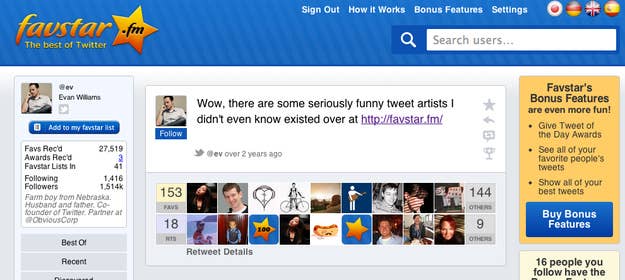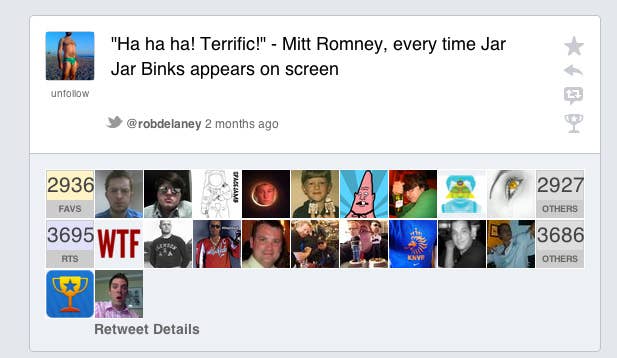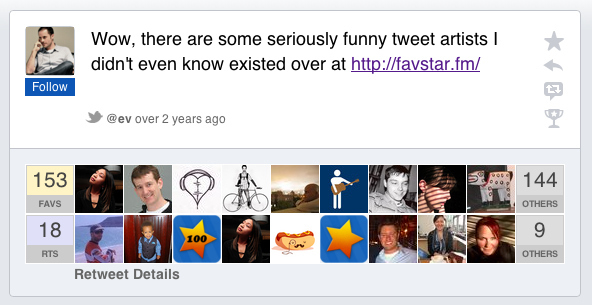
Twitter might be the most powerful joke machine ever created. As such, you don't have to look for jokes there — it's hard to find an active Twitter user who isn't practicing a voice, who doesn't have a schtick, who doesn't tell jokes with the assurance of a road-hardened standup. It's been said before but it bears saying again and again and again: on Twitter, everyone is a comedian.
The problem is, not everyone is a comedian. And while Twitter is great at keeping you in touch with people, and getting better at helping you find new people to follow, it's a site with a proud disinterest in the past. When you land on a user's page, you find a profile, a few recent tweets, and a list of followers. It's a movie box or an album cover, not a bio. (I can't even see more than 3200 of my own Tweets, which barely gets me back four months.)
That's where Favstar comes in. The site's concept is simple: it collects and ranks users' tweets by the number of times they've been favorited. It puts those tweets on a page.
Favstar is, at its core, a big, sortable database. But it's the closest thing Twitter has to a comedy circuit. And it might be in trouble.
***
Tim Haines, founder of Favstar, stumbled upon the idea almost by accident. It's hard to even call it an idea, really — he noticed something cool about Twitter, and decided to share it with people. "Back in 2009 I'd just published a couple of iPhone apps, and was wondering what I was going to do next," Haines told me. "I started to tinker with the Twitter API from pure geek curiosity, and noticed there was no way via their user interface (twitter.com) or API that you could see who has favorited your tweets."
Favorites have been a part of Twitter since (nearly) the beginning, but it was relegated to a behind-the-scenes role when Twitter starting blowing up. In 2009, as Haines mentioned, you couldn't see other users' favorites; shortly thereafter you could, but it wasn't until late 2011 that Twitter started promoting users' favorites for their friends to see.
Favstar's original purpose was to surface favoriting in a really basic way — to let users see who was liking their tweets. Since Twitter didn't offer a direct method for pulling other peoples' favorites, Haines developed his own. "I shared the same sort of analysis with a few friends, and found they had few tweets with a decent number of favs — they got a good buzz from it."
This simple Twitter trick was writ large as Favstar.fm, a site which, despite the addition of plenty of new features over the years — most notably a some powerful tweet-sorting tools — is basically just a set of leaderboards: the best tweets from each user, and from all users. The best tweets, more or less, on Twitter. (Note: Haines says it's pronounced Favvstar, like have, not Favestar. I had no idea.)
Favstar amplifies Twitter's addictive feedback system profoundly. On top of Twitter's tweet-by-tweet, fave-by-fave notifications, which can begin to feel like background noise, Favstar lets you know when you have a hit. @Favstar_Bot, one of many accounts that Favstar uses to notify its users of their prizes, has nearly two million tweets, all of which are some variation of "Congrats on your 50★ tweet!"
As depressing as it may sound, this is the closest thing a Twitter comedian (or just a funny person on Twitter) has to the sound of a room going wild. Once you start looking for it, you'll notice: even the most self-aware, savvy Twitter personalities, people who otherwise sneer at self promotion and follow-back requests, will enthusiastically retweet their Favstar notifications. For some, retweeting a Favstar notification is the only time they break character. Many even pay for Favstar's bonus features.
Favstar is also a place where lost accounts can live on — @agentlebrees, a personal favorite, exists nowhere else — or where personality-free accounts can be transformed (see @everyword's leaderboard).

Rob Delaney, a standup comedian and the professional bane of Mitt Romney's existence, is a fan. "I get a little serotonin blast in my addict mind when I see how many people favorite my tweet, I get high off that." But for him, it's also part of a toolset — it's a way for him to know how well he's doing, and which jokes are working. "It helps you improve as a purveyor of comedy," and anyway, he adds, "we now know that we all jerk off to how many retweets we get."
If Favstar is a valuable tool to a professional comedian, it's an invaluable tool to the people who don't really do comedy anywhere else, or who don't identify as comedians at all. These are Twitter natives, doing Twitter-native jokes for a smaller audience than Delaney's, and, unfortunately, a much smaller audience than the mega-popular @Lord_Voldemort7-style joke book-regurgitating semi-parody accounts. "I'm very inspired by [the natives]," says Delaney, "they're heroes to me. They blow my mind." People like @dril, @cool_pond, @fart, and @tricialockwood, he says, are like the delta force of Twitter comedy, writing material that's both deeply bizarre and inseparable from its platform. The rest of Twitter aspires to be the funniest person in the peanut gallery, but these people are doing something different. They're doing something purely creative that probably wouldn't exist anywhere else.

For a character like @cool_pond — a concept account that's a cross between an aloof teenager and a literal pond (it works, somehow) — Favstar is all there is, outside of the main timeline. If you see one of his tweets and think it's funny, you might check out his feed, see a few more, wonder what the hell he's doing and move on. But if you check his Favstar, you'll find gold, and a reason to follow. It's a resume of sorts. "I like it a lot," says _pond, "I think it's the best way to quickly see the best of everyone's best... [to] get a taste for what they're all about." Haines says it's not uncommon for users to curate their leader boards. "Many Favstar users do indeed use their Favstar page as a profile page," he says, "they delete mentions shortly after tweeting them, and delete tweets that don't do well. They want their Favstar pages to be filled with good content."
Favstar has begun to develop subcultures unto itself, both in the US and abroad — Haines says it's most popular in Japan, for reasons he's not quite sure of. "I've seen new forms of comedy evolving," Haines says.
***
Recent announcements from Twitter have signaled that the company plans to change its relationship with developers — that is to say, take back some of the control it's ceded to third party apps and services over the years. Haines says he's had a great relationship with Twitter, and that a number of Twitter employees are active users. Favstar was featured in Twitter sidebar back when there was such a thing, and they've been called out on multiple occasions by Twitter's founders:

"Recent times," Haines says, "have not been so cool." Twitter has embraced a few exclusive relationships, granting access to new, private API endpoints to select companies rather than to the developer community as a whole. Twitter's recent posts about the future of the ecosystem, Haines says, have been deeply unsettling. Twitter is expected to announce what's specifically changing soon; the chatter in the dev community is that an announcement is very close.
For now, like everyone who develops for Twitter — either an app like Tweetbot or a service like Favstar or Topsy — Tim Haines is on the edge of his seat. A subtle change in Twitter policy could be enough to shut his site down, and take those millions of leaderboards with it.
Favstar's 2.5m active users aren't nervous, in part because they're too busy making jokes to care about the subtly shifting breezes in the tech industry. They don't know. They're too busy making Twitter good, and documenting it on Favstar. To them, this simply organized exchange of funny things and goodwill just makes sense. It feels like a part of Twitter more than an extension of it. Why wouldn't it exist?
Update: The new rules are in, and Favstar seems to run afoul of at least a few. However, both Twitter and Favstar have signaled that a compromise should be workable. It'll ostensibly require special leniency on Twitter's part, and significant changes on Favstar's part.
The site, along with a few others, was namechecked in Twitter's announcement post — an reassuring endorsement that many other companies didn't get, and may soon wish they had.
